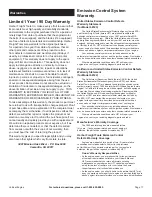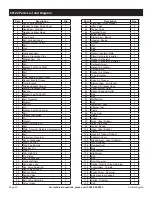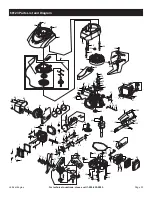
Page 13
For technical questions, please call 1-800-520-0882.
Vertical Engine
Checking and Filling Fuel
WARNING!
TO PREVENT SERIOUS
INJURY FROM FIRE:
Fill the fuel tank in a well-ventilated area away
from ignition sources. If the engine is hot from
use, shut the engine off and wait for it to cool
before adding fuel. Do not smoke.
1. Clean the Fuel Cap and the area around it.
2. Unscrew and remove the Fuel Cap.
3. If needed, fill the Fuel Tank to about 1 inch
under the fill neck of the Fuel Tank with 87
octane or higher unleaded gasoline.
Note:
Do not use gasoline containing more than
10% ethanol (E10). Do not use E85 ethanol.
Note: Do not use gasoline that has been stored in
a metal fuel container or a dirty fuel container. It
can cause particles to enter the carburetor, effecting
engine performance and/or causing damage.
4. Then replace the Fuel Cap.
5. Wipe up any spilled fuel and allow excess to evaporate
before starting engine. To prevent FIRE, do not start
the engine while the smell of fuel hangs in the air.
Engine Oil Change
CAUTION!
Oil is very hot during operation and can
cause burns. Wait for engine to cool before changing oil.
1. Make sure the engine is stopped.
2. Clean the top of the Dipstick and the area around it.
Remove the Dipstick by threading it counterclockwise.
3. Tilt the engine over a suitable oil container far enough
to allow all the oil to drain out. Recycle used oil.
4. Wipe off the dipstick with a clean lint free rag.
5. Add the appropriate type of oil until the oil level is at
the full level. SAE 10W-30 oil is recommended for
general use.
The
SAE Viscosity Grade
chart shows other
viscosities to use in different average temperatures.
10W-30
30
5W-30
-20
0
20
40
60
80
100°F
SAE Viscosity Grade
Average outdoor temperature
6.
Full level
Reinsert the Dipstick without threading it in and
remove it to check the oil level. The oil level should
be up to the full level, the top of the crosshatched
area on the dipstick as shown above.
7. Thread the dipstick back in clockwise.
CAUTION!
Do not run the engine with too little
oil. The engine will be permanently damaged.
Air Filter Element Maintenance
1. Remove the air filter cover and the air filter elements
and check for dirt. Clean or replace as described below.
2.
Cleaning:
• For “paper” filter elements:
To prevent injury from dust and debris, wear ANSI-
approved safety goggles, NIOSH-approved dust
mask/respirator, and heavy-duty work gloves. In
a well-ventilated area away from bystanders, use
pressurized air to blow dust out of the air filter.
If this does not get the filter clean, replace it.
• For foam filter elements:
Wash the element in warm water and mild
detergent several times. Rinse. Squeeze
out excess water and allow it to dry
completely. Soak the filter in lightweight oil
briefly, then squeeze out the excess oil.
3. Install the new filter or the cleaned filter.
Secure the Air Cleaner Cover before use.










































